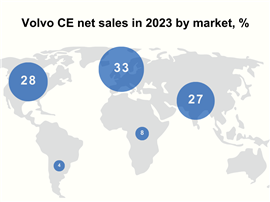4 things we learned from Volvo’s annual report
07 March 2024
 A Volvo EC230 Electric excavator does work in Los Angeles, US, as part of a pilot program run by Skanska. (Image: Skanska)
A Volvo EC230 Electric excavator does work in Los Angeles, US, as part of a pilot program run by Skanska. (Image: Skanska)
Volvo Construction Equipment recently unveiled its 2023 financial results, with sales up by 1% on a currency-adjusted basis to SEK 105 billion (US$10.1 billion), making up 19% of Volvo Group’s total sales.
Following the publication of the group’s annual report, Construction Briefing has delved into the detail to come up with four things we have learned about how the world’s sixth-biggest OEM (according to the Yellow Table) is faring and its plans for the future:
1) Volvo committed to electric machines but sales are still under 1,000 units
Volvo has made its commitment driving a transformation in the business with the launch of several electric products and supporting services in more markets. The company said it would continue to invest in battery-electric and fuel-cell electric technologies, as well as internal combustion engines running on low carbon fuels.
The scale of the transition that needs to take place was clear to see in a breakdown of the machine deliveries it made in 2023.
The business delivered a total of 60,064 units in 2023, down from 80,909 in the year before. A total of 45,494 of the machines delivered last year were large and medium construction equipment, along with 14,570 units of compact equipment.
Of all of these, 895 were fully electric, making up 1.5% of all machines delivered during the year. The number of fully electric machines delivered in 2023, although still small, was nearly 50% higher than in 2022, when the figure stood at 598 machines (0.74% of all machines delivered that year).
In its annual statement, Volvo said, “Already today, electric trucks and construction machines are viable options from a total cost of ownership perspective in certain segments in some markets. This development is expected to continue segment by segment and region by region, with demand for electric trucks and machines expected to increase.”
It said it remained “convinced” of the transformation given improvements in battery and hydrogen fuel cell technology and the development of charging networks. But it added, “The pace of electric transportation adoption will vary from region to region and depend on the availability of robust charging and hydrogen infrastructure.” It has got involved in several battery charging and infrastructure projects in Europe and North America as a result, it said.
The company introduced its first electric compact construction equipment in parts of Europe in 2020, before rolling out further into Europe, North America and then Asia. Its first medium-duty electric machine, the 23t EC230 electric excavator went into selected markets in 2022 and 2023. Fuel cells are expected to be an alternative for heavier construction machines towards the end of this decade.
Volvo is set to start building a large-scale production plant for battery cells in Mariestad in Sweden this year, specifically for commercial vehicles. And it has invested in battery pack production at its excavator plant in Changwon, South Korea, with production to start in June this year.
2) Europe overtakes Asia as Volvo’s biggest region by sales

In 2023, Europe became Volvo CE’s biggest geographical region by net sales, as Asia fell to third place. Out of a total of SEK 105 billion, sales in Europe accounted for SEK 34.2 billion, followed by North America on SEK 29.6 billion and Asia on SEK 28.2 billion. Africa and Oceania, and South America accounted for the rest of the total on SEK 8.9 billion and SEK 4.1 billion respectively.
That contrasted with the previous year when Asia was Volvo’s biggest geographical area, accounting for more than a third of its total net sales of SEK 100.2 billion. While Asia was top with SEK 34.2 billion, Europe was in second place on SEK 30.2 billion and North America third with 22.3 billion. In Africa and Oceania, and South America, net sales were SEK 7.1 billion and SEK 6.5 billion respectively.
The change in the order came about as downward pressure on the Chinese market continued. While the market in both North America and Europe softened in the second half of the year, there was “good development” in the first half, according to Volvo.
Overall, sales of Volvo-branded machines fell by 3% in 2023, while deliveries from its non-wholly-owned Shandong Lingong Construction Machinery (SDLG) business fell 48%.
Overall net sales increased, despite lower volumes, thanks to a favourable brand and market mix, as well as the price Volvo was able to command for its machines.
3) Volvo CE confident about long-term prospects for machine sales
 Volvo CE’s ECR40 compact excavator. (PHOTO: Volvo CE)
Volvo CE’s ECR40 compact excavator. (PHOTO: Volvo CE)
Volvo acknowledged that in the short term, there is “uncertainty” among its customers due to higher interest rates and lower economic growth.
Summing up the financial performance of its Construction Equipment arm for the year, Volvo said, “Rental fleet replacements supported the European market early in the year but demand weakened during the course of the year in line with a weaker macroeconomic outlook, elevated inflation and increasing interest rates.”
Meanwhile in North America it explained that the market was enjoying the support of large infrastructure projects and good commercial construction but it had softened in the fourth quarter due to would-be buyers deferring their fleet replacement amid high interest rates.
In Brazil, sales were subdued due to low business confidence among customers. And in addition to a continued weak market in China, other Asian markets slowed down later in 2023.
Despite the fact that the volume of the machines it sold during 2023 declined (see above), Volvo said it remained confident about the longer-term prospects for sales.
It explained that this is because countries will not only have to renew aging infrastructure but also because populations and economies continue to grow.
4) Plans to grow services business further
While machine sales were flat at 1% in 2023, Volvo CE’s service sales grew by 4% to SEK 16 billion in 2023.
And the OEM said it had plans to develop the service business further in the coming years.
It said it wanted to focus on the “untapped potential” that exists in terms of market share and increasing the sales of spare parts, workshop hours, financing insurance and uptime services.
The company said it had sold 2.1 million trucks and 700,000 construction machines in the last 10 years, many of which are connected. “With these as a base, we can extend our service offer and increase the uptime and productivity to the benefit of our customers,” the company said.
It also outlined plans to continue the rollout of its ‘Equipment as a Service’ (EaaS) offering, which focuses on use rather than ownership of construction equipment.
The company said the service “helps Volvo customers to invest more capital in growing their core business operations profitably, while boosting Volvo CE’s ambition of increasing revenue from services”.
Click here to read more about Volvo’s 2023 financial results.
Brought To You By
|
STAY CONNECTED



Receive the information you need when you need it through our world-leading magazines, newsletters and daily briefings.
CONNECT WITH THE TEAM








